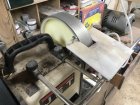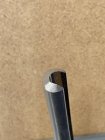Randy, I use a Grizzly wet sharpener with Tormek jigs, the SVD-186 for gouges. I use more of an Ellsworth 40° grind. The wings are longer than the Stuart Batty 40-40. I tried the shorter wings, which are what I call an Irish grind, and moved on to the longer wings simply because there is more edge for sheer scraping and peeling cuts. Anyway, my point is the Tormek jig can approximate the 40-40 grind. The angle of the edges is more acute, more like 30° at the end of my longer wings, and of course the angle gradually changes from the nose to the end of the wing, so an Irish grind would end up with ~35° angle at the end of the wing at the top of the flute. I set the SVD-186 to #3, with a tool projection of 75mm, and the bar set at hole "A" of the TTS-100. A pic of my 5/8" Benjamin's Best bowl gouge is below. Interestingly the flute of this gouge looks to be the same shape as the Crown Razor Edge 5/8" and Jamieson-Thompson 5/8" bowl gouges I have, i.e. parabolic. The Janieson gouge came with his signature grind, a 60° Ellsworth long wing. My jig settings for my 60° gouges matched up almost perfectly with his grind.
The picture you posted of your attempt at a 40-40 grind looks like a traditional grind to me, with little wing sweep. You are not spending enough time grinding the wings back, which on a wet sharpener takes forever. Do yourself a favor and get an 8" slow grinder and the Tormek BGM-100 tool rest bar for bench grinders. You can set the tool rest bar with the bench grinder using the Tormek TTS-100 the same as you do on the Tormek. Set your gouge jig, rough in whatever shape you want on the bench grinder quickly, then move right over to the Tormek to sharpen your edge, no changing of anything, then do all your re-sharpening on the Tormek. I use a secondary bevel for 2 reasons: 1) grind the gouge heel out of the way, and 2) reduce the amount of time it takes to re-sharpen on the wet grinder. I create the primary bevel with the jig with a different setting on the bench grinder, then reset the jig and move to the wet sharpener to create the secondary cutting bevel and edge. I get a 1/2 dozen or more re-sharpenings before going back to the bench grinder to redo the primary bevel. You will find reshaping of any tool much quicker with a bench grinder, and then use the Tormek to get your final edge.
I agree with you that there isn't a magic sharpening technique or shape. As long as the shape is reasonable and the edge is sharp, the rest comes down to the "operator" and tool control.
Edit: I just watched the Cindy Drozda video, and realized my edge angles are closer to 40° than I thought. I was measuring across the flutes to find the complimentary angle, so I was not measuring the angle with respect to the flute side as she shows, which means my side angles are steeper than I measured. Have to take another shot at measuring them.




